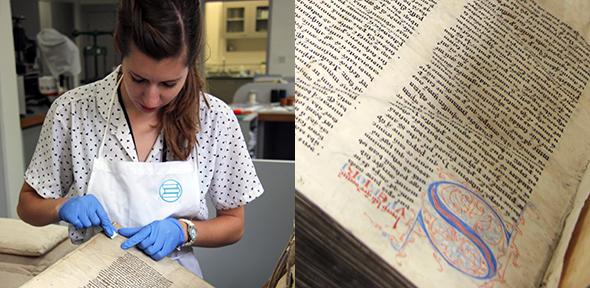
A Cambridge University Library conservator and the library’s manuscripts have helped to solve a longstanding mystery.
In the thirteenth century, thousands of so-called Paris Bibles were produced – small format portable bibles written on tissue-thin leaves of parchment. For years scholars have wondered about the source of this fine parchment. The use of the term abortivum in medieval sources led to the suggestion that it may have derived from unborn or newborn calves or lambs. Given the enormous scale of bible production, this does not seem sustainable and the idea was put forward that it derived from thinner-skinned mammals such as squirrels or rabbits. Now bioarchaeologists working with conservators and manuscript scholars have developed a simple non-destructive technique for determining the origin species of parchment.
The technique, non-invasive peptide fingerprinting, was devised by scientists from the BioArCh (Biology, Archaeology and Chemistry) team in the Department of Archaeology at the University of York. Cambridge University Library Book and Paper Conservator, Emma Nichols, extracted protein from parchment leaves using an electrostatic charge generated by gentle rubbing of a PVC eraser on the surface of the page. She sent the waste from the eraser, carefully handled and labelled to avoid contamination, to York where protein mass spectrometry was used to extract peptide sequences from the collagen picked up by the rubbings. These collagen peptides have unique masses which act like a fingerprint; each species has its own characteristic pattern, allowing the scientists to identify the type of animal easily.
Emma has been collaborating with the scientists from BioArCh on their ‘Books and Beasts’ project for nearly three years. Since arriving at Cambridge University Library she has aided with the collagen analysis of over 200 leaves of parchment spanning 1200 years of history from five different CUL collections. She delivered a public presentation explaining the science and technology behind the project at the Festival of Science in 2014.
To answer the question concerning the ultra-fine parchment used in Paris Bibles, the team analysed samples from 72 manuscripts, including 24 provided by Emma from collections in Cambridge University Library. They found no squirrels or rabbits had been used and that sheep, calf and goat skins were used across Europe in proportion to their use in other types of manuscript, suggesting that the thin parchment did not necessarily derive from unborn animals but was more likely to be the result of a highly specialised and still unknown production process.
Emma is still working with the scientists and is now helping them to discover whether it is possible to perform non-destructive DNA sampling of parchment to answer more questions about the production and use of medieval manuscripts.
For more on the research, see the recently-published paper.
